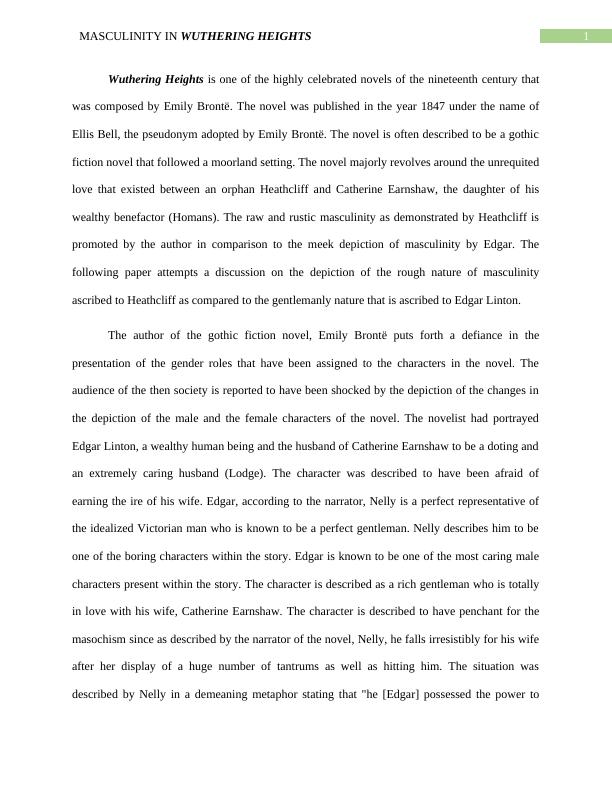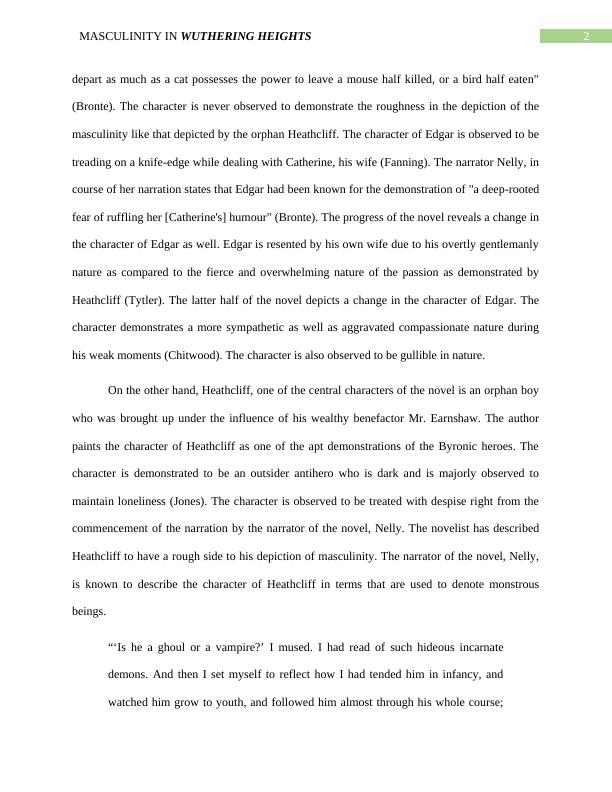Contrasting Masculinities in Wuthering Heights
Added on 2023-04-26
6 Pages1423 Words128 Views
Running head: MASCULINITY IN WUTHERING HEIGHTS
MASCULINITY IN WUTHERING HEIGHTS
Name of the Student
Name of the University
Author Note
MASCULINITY IN WUTHERING HEIGHTS
Name of the Student
Name of the University
Author Note

1MASCULINITY IN WUTHERING HEIGHTS
Wuthering Heights is one of the highly celebrated novels of the nineteenth century that
was composed by Emily Brontë. The novel was published in the year 1847 under the name of
Ellis Bell, the pseudonym adopted by Emily Brontë. The novel is often described to be a gothic
fiction novel that followed a moorland setting. The novel majorly revolves around the unrequited
love that existed between an orphan Heathcliff and Catherine Earnshaw, the daughter of his
wealthy benefactor (Homans). The raw and rustic masculinity as demonstrated by Heathcliff is
promoted by the author in comparison to the meek depiction of masculinity by Edgar. The
following paper attempts a discussion on the depiction of the rough nature of masculinity
ascribed to Heathcliff as compared to the gentlemanly nature that is ascribed to Edgar Linton.
The author of the gothic fiction novel, Emily Brontë puts forth a defiance in the
presentation of the gender roles that have been assigned to the characters in the novel. The
audience of the then society is reported to have been shocked by the depiction of the changes in
the depiction of the male and the female characters of the novel. The novelist had portrayed
Edgar Linton, a wealthy human being and the husband of Catherine Earnshaw to be a doting and
an extremely caring husband (Lodge). The character was described to have been afraid of
earning the ire of his wife. Edgar, according to the narrator, Nelly is a perfect representative of
the idealized Victorian man who is known to be a perfect gentleman. Nelly describes him to be
one of the boring characters within the story. Edgar is known to be one of the most caring male
characters present within the story. The character is described as a rich gentleman who is totally
in love with his wife, Catherine Earnshaw. The character is described to have penchant for the
masochism since as described by the narrator of the novel, Nelly, he falls irresistibly for his wife
after her display of a huge number of tantrums as well as hitting him. The situation was
described by Nelly in a demeaning metaphor stating that "he [Edgar] possessed the power to
Wuthering Heights is one of the highly celebrated novels of the nineteenth century that
was composed by Emily Brontë. The novel was published in the year 1847 under the name of
Ellis Bell, the pseudonym adopted by Emily Brontë. The novel is often described to be a gothic
fiction novel that followed a moorland setting. The novel majorly revolves around the unrequited
love that existed between an orphan Heathcliff and Catherine Earnshaw, the daughter of his
wealthy benefactor (Homans). The raw and rustic masculinity as demonstrated by Heathcliff is
promoted by the author in comparison to the meek depiction of masculinity by Edgar. The
following paper attempts a discussion on the depiction of the rough nature of masculinity
ascribed to Heathcliff as compared to the gentlemanly nature that is ascribed to Edgar Linton.
The author of the gothic fiction novel, Emily Brontë puts forth a defiance in the
presentation of the gender roles that have been assigned to the characters in the novel. The
audience of the then society is reported to have been shocked by the depiction of the changes in
the depiction of the male and the female characters of the novel. The novelist had portrayed
Edgar Linton, a wealthy human being and the husband of Catherine Earnshaw to be a doting and
an extremely caring husband (Lodge). The character was described to have been afraid of
earning the ire of his wife. Edgar, according to the narrator, Nelly is a perfect representative of
the idealized Victorian man who is known to be a perfect gentleman. Nelly describes him to be
one of the boring characters within the story. Edgar is known to be one of the most caring male
characters present within the story. The character is described as a rich gentleman who is totally
in love with his wife, Catherine Earnshaw. The character is described to have penchant for the
masochism since as described by the narrator of the novel, Nelly, he falls irresistibly for his wife
after her display of a huge number of tantrums as well as hitting him. The situation was
described by Nelly in a demeaning metaphor stating that "he [Edgar] possessed the power to

2MASCULINITY IN WUTHERING HEIGHTS
depart as much as a cat possesses the power to leave a mouse half killed, or a bird half eaten"
(Bronte). The character is never observed to demonstrate the roughness in the depiction of the
masculinity like that depicted by the orphan Heathcliff. The character of Edgar is observed to be
treading on a knife-edge while dealing with Catherine, his wife (Fanning). The narrator Nelly, in
course of her narration states that Edgar had been known for the demonstration of "a deep-rooted
fear of ruffling her [Catherine's] humour" (Bronte). The progress of the novel reveals a change in
the character of Edgar as well. Edgar is resented by his own wife due to his overtly gentlemanly
nature as compared to the fierce and overwhelming nature of the passion as demonstrated by
Heathcliff (Tytler). The latter half of the novel depicts a change in the character of Edgar. The
character demonstrates a more sympathetic as well as aggravated compassionate nature during
his weak moments (Chitwood). The character is also observed to be gullible in nature.
On the other hand, Heathcliff, one of the central characters of the novel is an orphan boy
who was brought up under the influence of his wealthy benefactor Mr. Earnshaw. The author
paints the character of Heathcliff as one of the apt demonstrations of the Byronic heroes. The
character is demonstrated to be an outsider antihero who is dark and is majorly observed to
maintain loneliness (Jones). The character is observed to be treated with despise right from the
commencement of the narration by the narrator of the novel, Nelly. The novelist has described
Heathcliff to have a rough side to his depiction of masculinity. The narrator of the novel, Nelly,
is known to describe the character of Heathcliff in terms that are used to denote monstrous
beings.
“‘Is he a ghoul or a vampire?’ I mused. I had read of such hideous incarnate
demons. And then I set myself to reflect how I had tended him in infancy, and
watched him grow to youth, and followed him almost through his whole course;
depart as much as a cat possesses the power to leave a mouse half killed, or a bird half eaten"
(Bronte). The character is never observed to demonstrate the roughness in the depiction of the
masculinity like that depicted by the orphan Heathcliff. The character of Edgar is observed to be
treading on a knife-edge while dealing with Catherine, his wife (Fanning). The narrator Nelly, in
course of her narration states that Edgar had been known for the demonstration of "a deep-rooted
fear of ruffling her [Catherine's] humour" (Bronte). The progress of the novel reveals a change in
the character of Edgar as well. Edgar is resented by his own wife due to his overtly gentlemanly
nature as compared to the fierce and overwhelming nature of the passion as demonstrated by
Heathcliff (Tytler). The latter half of the novel depicts a change in the character of Edgar. The
character demonstrates a more sympathetic as well as aggravated compassionate nature during
his weak moments (Chitwood). The character is also observed to be gullible in nature.
On the other hand, Heathcliff, one of the central characters of the novel is an orphan boy
who was brought up under the influence of his wealthy benefactor Mr. Earnshaw. The author
paints the character of Heathcliff as one of the apt demonstrations of the Byronic heroes. The
character is demonstrated to be an outsider antihero who is dark and is majorly observed to
maintain loneliness (Jones). The character is observed to be treated with despise right from the
commencement of the narration by the narrator of the novel, Nelly. The novelist has described
Heathcliff to have a rough side to his depiction of masculinity. The narrator of the novel, Nelly,
is known to describe the character of Heathcliff in terms that are used to denote monstrous
beings.
“‘Is he a ghoul or a vampire?’ I mused. I had read of such hideous incarnate
demons. And then I set myself to reflect how I had tended him in infancy, and
watched him grow to youth, and followed him almost through his whole course;

End of preview
Want to access all the pages? Upload your documents or become a member.
Related Documents
Assignment on Patriarchal Opression on Feminine Naturelg...
|10
|3017
|110
Visual Acts and Metaphors in Wuthering Heightslg...
|4
|741
|412
The Importance of Gaze and Visual Metaphorslg...
|4
|741
|86
Wuthering Heights by Emily Jane Brontë Reviewlg...
|5
|1456
|19
